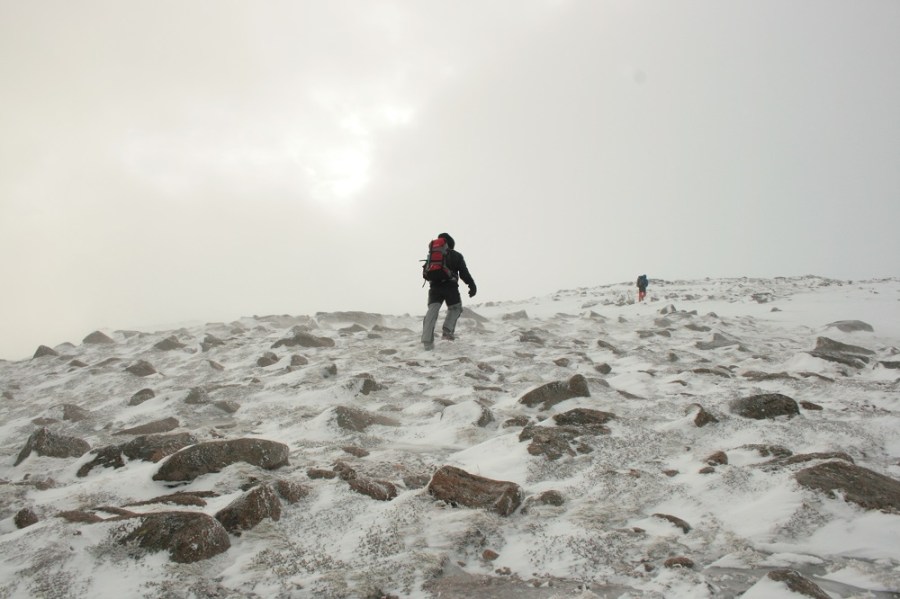The low-down from Heather Morning of the Mountaineering Council of Scotland on using PLBs and SENDs
Mountaineering news this winter has been dominated by two massive searches for people who went missing on Ben Nevis and in the Cairngorms. These searches, involving hundreds of man-hours in searching huge areas of rough and mountainous terrain, have highlighted the importance of letting people know where you are going in the mountains – especially when travelling alone.
But it’s not always possible, and sometimes plans have to change.
One solution increasingly being adopted by outdoor people is to take advantage of satellite technology, using Personal Locator Beacons (PLBs) or Satellite Emergency Notification Devices (SENDs).
Both have considerable advantages, but also limitations and pitfalls, so it’s important to know some of the basics before jumping in.
What are PLBs and how do they work?
A PLB is primarily a life-saving device, similar to the size of a mobile phone, which radios distress signals to orbiting weather satellites. Once triggered, the PLB will alert the emergency services to your exact location. Satellite technology ensures that PLBs are a more reliable way of calling for help than mobile phone, as they only need a clear view of the sky, unlike a mobile phone which relies on a signal from a land based transmitter. PLBs do not require an annual subscription.
What are Satellite Emergency Notification Devices and how do they work?
SENDs – the SPOT Messenger is probably the best known of these – are not just an emergency device. Besides sending an SOS distress message to the International Emergency Response Co-ordination Centre in Houston, Texas, SENDs can notify friends and family with short, pre-arranged status messages, accompanied always with your GPS position. Users of SENDs must have an annual service plan or they do not function. They work in many areas of the world, but there are some significant gaps.
Do you need a PLB or SEND?
If you head out into the mountains alone, particularly in areas where mobile phone reception is either poor or non-existent, then one of these devices could save your life.
Different hill users have different needs. If you habitually go out alone, the SEND’s advantage is that you can turn on the tracking function and even if you fall and are unconscious, your position is logged – provided that you have told your Emergency Point of Contact that you are out and about and want them to keep an occasional eye on you. If you are looking for a handy device to track your route and update family and friends, the SEND is the tool for the job.
If you’re looking for an emergency transmitter that will notify emergency services of your distress – and which has the facility for SAR helicopters to ‘home in’ to it – a PLB is the most reliable choice. But remember, a PLB has to be manually activated, so if you or your party fall and are unconscious or are avalanched and buried, then you may be unable to access or activate the device.
Some important do’s and don’ts for users of PLB & SENDs
- It is essential that you register your beacon with the UK Distress & Security Beacon Registry. This is free and a simple job, providing the emergency services with up to three Emergency Point of Contact details should your unit ever be triggered.
- If you do not register your unit then the emergency services will still respond, however, without the Emergency Point of Contact details the response may be significantly delayed.
- It is estimated that over 50% of all UK-coded beacons have not been registered.
- It is essential that you only activate your emergency beacon in a life-threatening situation, when you are unable to ‘self-rescue’. Be aware that your call may divert lifesaving resources away from other people in dire need of help.
- If you activate your beacon, ensure it is in a position where it has a clear view of the sky to maximise its potential of being ‘seen’ by passing satellites.
- Once you trigger your PLB you should ideally remain in the same location. Your PLB transmits a half-second data burst every 50 seconds. If you move after activating your PLB, the emergency services may initially be sent to the wrong location, resulting in confusion and delay.
- If you have activated your PLB, do not switch it off.
- For SENDs, be aware that, once you have triggered your beacon it may take up to 30 minutes to get a signal out, depending on the current position of passing satellites.
- The vast majority of beacons triggered in the UK in 2015 were false alarms that wasted a huge amount of time. The danger of false alerts diverting search and rescue resources from genuine incidents should always be borne in mind.
How much do PLBs and SENDs cost?
PLB’s are available at Tiso stores in Scotland and on-line. You can expect to pay about £170 upwards.
SENDs retail at £140 upwards depending on the model, plus an annual service plan typically starting at £100 for the basic service.
Click here for more from the Mountaineering Council of Scotland.
Image by Carey Davies








